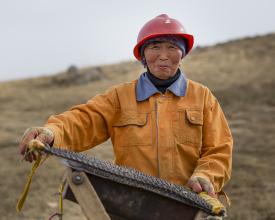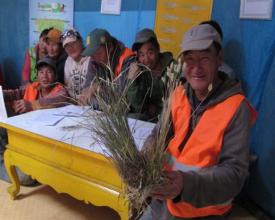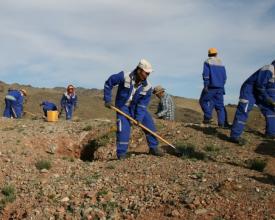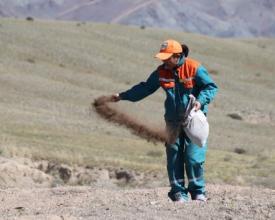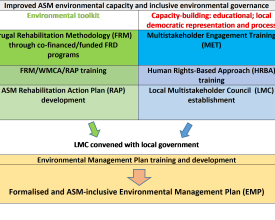
Environmental Rehabilitation: Learnings from Artisanal Miners in Mongolia

Artisanal mining can significantly degrade the environment. It is also a difficult sector to engage with given its informality and lack of institutional identity.
The Frugal Rehabilitation Methodology (FRM) is a practical approach that is economically affordable, socially acceptable and equally importantly, ecologically viable. FRM is comprised of the following six steps:
1. Preparation and Planning;
2. Technical Rehabilitation;
3. Topsoils: identification, conservation/storage and use;
4. Biological rehabilitation;
5) Mitigation hierarchy/whole mine cycle approach;
6. Handover of completed rehabilitation site to relevant government administrations for approval/sign-off.
The technical and biological rehabilitation prescriptions are specifically designed for application at degraded and abandoned ASM sites as well as active ASM areas that are soon to be rehabilitated. The prescriptions are specifically designed for artisanal mining of alluvial and hard rock deposits.
Contexte
Challenges addressed
One of the key obstacles to stakeholder and acceptance to ASM communities is a negative reputation associated with poor environmental performance, land degradation and pollution. This was recognised in Mongolia as a primary obstacle to formalisation and social acceptance amongst impacted stakeholders; artisanal miners would need to demonstrate improved rehabilitation commitments and practices, but there would be challenges associated with economic affordability and the technical capacity of the sector. Therefore the concept of FRM was considered as a practical approach to rehabilitation that would be economically affordable, socially acceptable and equally importantly, ecologically viable. In every context, the FRM would need to balance these three considerations.
Emplacement
Traiter
Summary of the process
The Frugal Rehabilitation Methodology (FRM) is an environmental tool that can be delivered through partnership at the national and local levels of government and through engagement with local stakeholders. Developing and cultivating consensus among parties on the value and efficacy of the FRM is important and this step is crucial. Participatory approaches to selecting, evaluating and learning from frugal rehabilitation demonstration establishes a platform for the methodology to be adopted, incorporated into legislation and integrated into local environmental management planning systems. The following graphic indicates such a model:
Building Blocks
Ministerial and Sectoral Alignment: a partnership-based approach to developing a Frugal Rehabilitation Methodology
Acknowledging and identifying conflicts between ministries and sectoral stakeholders is important. It is important at the early stages of an initiative to recognise these problems and to establish and work through a consultative platform to make the case for a methodology that is of value to all stakeholders, that is inclusive of artisanal miners and the stakeholders impacted by such mining as well as government ministries. It is only through such collaboration that a methodology can be developed that addresses environmental concerns, meets artisanal miners needs for performance-based incentives and access to land, and can be valued by government in formalising condition-based permitting for mining. It is within the context and platform of engagement that the FRM can be demonstrated to be of value to all stakeholders, and deliver outcomes at the local as well as national level.
Enabling factors
- Government recognition of range of problems across the sector
- Government alignment on best environmental practices and effective enforcement
- Government willingness to engage in wider partnerships to assess problems associated with informal ASM and to seek solutions and incentives for better environmental practices
- National and stakeholder willingness for ASM formalisation to be conditional on environmental performance
- ASM sector willing to implement FRM
- Stakeholders willing to endorse ASM licensing based on improved environmental practices
Lesson learned
It is critical for the initiative to have support from the national government, as a gateway to engaging with local government and other local stakeholders impacted by artisanal mining. Also, it is important that leading ministries that may potentially hold conflicting views (e.g. mining and environment) appreciate and support the initiatives’ capacity for developing solutions and approaches that can deliver benefits of interest to all parties (ministries).
Establishment of National FRM working group with government and sectoral stakeholders
On the basis that government ministries are willing and able to work together to develop solutions to address impacts of ASM on the wider environment, Protected Areas and on stakeholders impacted by such mining activity, a national working group (which includes such ministries, agencies and relevant representative stakeholders) needs to be established. This will help steer the process of project engagement with local government, artisanal miners and wider stakeholders at the local level to set the scene for Frugal Rehabilitation Demonstration (FRD). A key step in this process is to select sites for FRD that can serve the development and application of the methodology within the ecological, economic and social context. The purpose of establishing this FRM working group is to ensure a participatory, consultative approach to the development of the methodology, and to enable a demonstration site selection process that ensures an informed and strategic approach based on agreed criteria. Sites selected for methodology demonstration need to be typical, representative and associated with formalised ASM capacity to undertake the rehabilitation.
Enabling factors
The key enabling factors were the collaborative approach to developing the FRM and adequate resources to undertake the participatory approach both at meetings and in the field. The working group was involved in a coordinated travel program to select, assess, monitor and review rehabilitation progress and approaches at sites.
Lesson learned
The working group’s participation and involvement in the development of the FRM was critical to its eventual endorsement and adoption. Key ministries and associated agencies played a role in selecting FRD sites, visiting them through the rehabilitation process and discussing the development of a methodology that was informed through action-research across a range of representative sites. It was also important to have exposure and engagement with formalised artisanal miners, who were keen to participate in the work and help develop a mechanism for promoting best practice and their association with such practice.
Frugal Rehabilitation Demonstration (FRD): developing and adapting the methodology (FRM) through action-research
Once demonstration sites are selected, local ASM groups receive training and are contracted to implement FRM through six steps:
- Preparation & Planning: degradation, boundary, hydrological & equipment assessments; labor, volume estimates; waste management; OHS standards
- Technical Rehabilitation: infill, regrading and reprofiling; use of limited mechanisation
- Topsoils: identification, conservation and re-distribution across sites
- Biological Rehabilitation: topsoil enrichment ; natural regeneration assessments; identification of native and key vegetation communities; seed collection; seeds and natural fertilizers distribution into topsoils; tree, shrub and grass plantings
- Mitigation Hierarchy: integrating rehabilitation planning into active ASM design and operations so as to reduce primary environmental impacts and unnecessary rehabilitation efforts
- Handover of completed rehabilitation site to relevant government administrations for approval/sign-off
Enabling factors
- National and local government permission to implement Frugal Rehabilitation Demonstration projects.
- Resources to fund demonstration labour effort and technical application of methodology at site.
- ASM capacity and willingness to receive training and implement the methodology on site.
Lesson learned
- Successful application of the FRM: all the key physical and ecological requirements for successful rehabilitation are (with few exceptions) available within reasonable proximity of the site. They just need to be identified and adapted to context.
- Habitat rehabilitation targeted to native vegetation communities can be successful without the use of non-native species.
- Identification and recovery of topsoils are critical to success.
- Biological rehabilitation works well together with topsoil seedbank to establish a path to ecological recovery.
- Low level mechanised approaches to heavy-lifting of material in topographic filling can be effective but a dependence on mechanisation in the later stages of rehabilitation is not recommended. Overuse of machinery in these latter phases can result in reduced capacity for biological recovery.
- FRM can be applied in abandoned areas, where mineral reserves are exhausted, and it can also be integrated into current ASM operations to reduce rehabilitation efforts.
- Handover and sign-off from local authorities is key to ensure ongoing commitment.
Impacts
The following positive impacts were observed after the study in Mongolia:
- Successful siting, development, implementation and monitoring of 17 Frugal Rehabilitation Demonstration projects across 11 of Mongolia’s 16 ecological zones
- Development of a guide to apply FRM in other contexts
- Improved rehabilitation commitments by ASM in Mongolia
- Capacity-building of multi-stakeholder in inclusive approaches to environmental governance
- FRM went through an exhaustive consultative process with national government and other stakeholder advisors, resulting in an approved attachment to a revised Regulation for Artisanal and Small-scale Mining to be passed by the government
Beneficiaries
FRM has ensured that the formalised ASM sector operates to a higher standard of environmental responsibility, and addresses rehabilitation of degraded lands. Main beneficiaries are ASM and local communities, the Ministry of Mines and Environment.
Sustainable Development Goals
Story
Artisanal and small-scale mining in Mongolia is driven by economic hardship and opportunity and yet causes a wide variety of environmental and social problems. In 2016, The Asia Foundation’s Mongolia team was running an Environmental Planning workshop in Gurvantes in the South Gobi. The workshop was attended by Protected Area administrators from the Ministry of Environment as well as government officials. After the workshop our party travelled north into the Nemegt Uul, a range of mountains within the Gobi Gurvan Saikhan National Park, where in recent years, illegal artisanal gold mining had penetrated these mountains, degrading the slopes and dry riverbeds and causing severe impacts on wildlife and livestock of nomadic herders. The presence of officials was important. The project’s commitment to supporting and implementing the FRM within a number of Protected Areas was key to maintaining the Ministry of Environment’s interest and faith in the project’s key goal.
At the beginning of the project, the Environment Ministry was in conflict with the Ministry of Mining. Their response to the widespread impacts of illegal artisanal mining was to ban the sector completely. The project’s aim was to develop a rehabilitation methodology that could be used to achieve formalisation of the ASM sector, conditional upon effective rehabilitation and commitment to confirm PAs as no-go areas for ASM. Showing that artisanal miners could effectively rehabilitate damage caused in such Protected Areas was key to the relationship and such undertakings had been implemented at four Protected Areas in different ecosystems across the country. The Nemegt site was one such demonstrated commitment.
I remember it was mid-afternoon in June when we walked onto the site. Rehab had been undertaken the previous year, when hundreds of pits and shafts had been infilled and reprofiled, demonstrating that rehabilitation was affordable and achievable at a challenging site. The previous summer (2015) had fortunately seen good rains, which had helped the biological rehabilitation. We walked right into the middle of the rehabilitation area. A leading official from the Protected Areas Administration asked, “Well, where is this mine site?” My response was “You are standing in the middle of it.” For a moment, he and his colleagues were bewildered, and then they smiled, as they realised what has been achieved. Frugal rehabilitation works.
